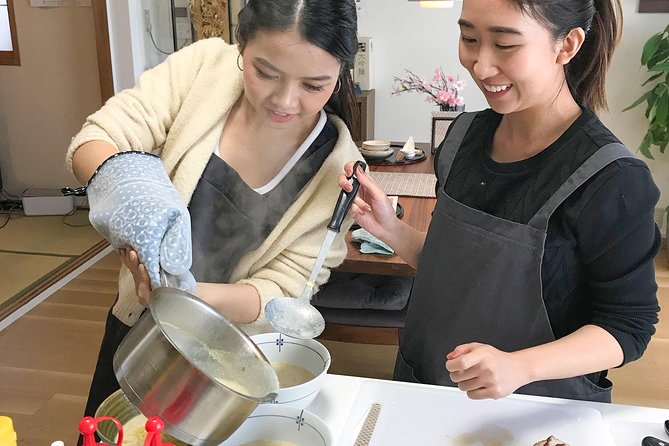Here, readers will discover the joy of preparing homestyle ramen and gyoza from scratch. From booking to tasting, this guide will take them through the step-by-step process of creating these delicious Japanese dishes.
With the help of Japanese Cooking Studio -WA-, readers can learn the art of making the perfect ramen broth, cooking homemade gyoza, and preparing noodles like a pro.
Whether experienced chefs or kitchen amateurs, this article will inspire and guide readers to create authentic and mouthwatering ramen and gyoza at home.
Quick Takeaways

- Homestyle ramen and gyoza can be made using easily accessible ingredients found in most grocery stores.
- Vegetarian alternatives are available for both the ramen and gyoza fillings.
- Regional variations in ingredients and broth types, such as soy-based broth in Tokyo-style ramen and miso-based broth in Hokkaido-style ramen, offer diverse flavor profiles.
- Toppings and garnishes, such as chashu, soft-boiled eggs, nori, and green onions, add texture, color, and layers of flavor to the dishes.
Ingredients for Homestyle Ramen and Gyoza
The recipe for Homestyle Ramen and Gyoza requires a specific set of ingredients that can be easily found in most grocery stores. To cater to different dietary preferences, there are vegetarian alternatives available for both the ramen and gyoza fillings.
For the ramen, instead of using traditional pork-based broth, vegetable broth can be used as a flavorful substitute. The gyoza filling can be made with a combination of vegetables like cabbage, carrots, and mushrooms, seasoned with soy sauce and ginger.
Regional variations also play a role in the ingredients used. For example, in Tokyo-style ramen, the broth is typically soy-based, while in Hokkaido-style ramen, the broth is rich and creamy from the addition of miso. These variations add depth and uniqueness to the overall flavor of the dish.
Step-by-Step Guide to Making Ramen Broth

To make the ramen broth, begin by simmering the ingredients in a flavorful liquid. Ramen broth is the heart and soul of this beloved Japanese dish, and there are various variations of flavors to choose from. The most common types of ramen broth include shio (salt-based), shoyu (soy sauce-based), miso (fermented soybean-based), and tonkotsu (pork bone-based). Each variation has its own unique taste and aroma, adding depth and complexity to the dish.
To achieve a rich and flavorful broth, it’s important to simmer the ingredients for an extended period of time. This allows the flavors to meld together and intensify. Traditional toppings for ramen and gyoza include sliced chashu (braised pork belly), marinated soft-boiled eggs, menma (bamboo shoots), nori (seaweed), and green onions. These toppings add texture, color, and additional layers of flavor to the dish.
How to Perfectly Cook Homemade Gyoza

To achieve perfectly cooked homemade gyoza, follow these simple steps.
First, prepare the dumpling wrappers by combining all-purpose flour and water until a smooth dough forms. Roll the dough into a thin sheet and cut out circles using a round cutter.
Next, make the filling by combining ground pork, minced garlic, grated ginger, soy sauce, sesame oil, and finely chopped cabbage. Place a small spoonful of filling in the center of each wrapper and fold it in half, pleating the edges to seal.
Now, it’s time to cook the gyoza. Heat oil in a non-stick skillet and arrange the dumplings in a single layer. Cook on medium heat until the bottoms turn golden brown.
Add water to the skillet, cover, and steam for a few minutes until the wrappers are translucent and the filling is cooked through.
Serve with a dipping sauce made from soy sauce, rice vinegar, and chili oil.
If you want to experiment with different flavors, try alternative dumpling fillings like shrimp and chive or vegetarian options with mushrooms and tofu.
With these cooking techniques and creative fillings, you’ll be able to enjoy perfectly cooked homemade gyoza every time.
Tips for Noodle Preparation and Assembly
.jpg)
Noodle preparation and assembly require careful attention to achieve the perfect bowl of homemade ramen. When it comes to noodle cooking techniques, there are a few tips to keep in mind.
First, make sure to cook the noodles according to the package instructions, but aim for a slightly firmer texture to prevent them from becoming mushy in the hot broth. Plus, rinsing the cooked noodles under cold water can help remove excess starch and prevent them from sticking together.
As for flavor variations for the ramen broth, there are endless possibilities. Traditional options include shoyu (soy sauce), miso, and tonkotsu (pork bone), each with its own distinct taste. Experimenting with different ingredients like garlic, ginger, sesame oil, or even adding a splash of vinegar or mirin can elevate the flavors even further.
Remember to adjust the seasoning to your taste and don’t be afraid to get creative with toppings like sliced pork, soft-boiled eggs, nori, or scallions. With these tips, you’ll be well on your way to enjoying a delicious homemade bowl of ramen.
Serving Suggestions and Garnishing Ideas
.jpg)
Serving suggestions and garnishing ideas for homemade ramen and gyoza include a variety of toppings and condiments. Here are some ideas to enhance your culinary experience:
-
Variations of ramen and gyoza fillings: Experiment with different fillings for your gyoza, such as pork and cabbage, chicken and mushroom, or even vegetarian options like tofu and spinach. For ramen, try adding sliced roasted pork, marinated soft-boiled eggs, or even seafood like shrimp or scallops.
-
Pairing ramen and gyoza with complementary side dishes: Serve your homemade ramen and gyoza with a side of steamed rice, pickled vegetables, or a fresh and crisp salad. You can also offer a selection of dipping sauces like soy sauce, chili oil, or ponzu for added flavor.
-
Don’t forget the garnishes: Sprinkle some chopped green onions, sesame seeds, or nori seaweed on top of your ramen to add visual appeal and extra taste. For gyoza, a drizzle of soy sauce and a sprinkle of toasted sesame seeds can make all the difference.
-
Play with textures: Consider adding crispy fried garlic or shallots, crunchy bean sprouts, or sautéed mushrooms as toppings for your ramen and gyoza. This will add a delightful crunch and depth of flavor to your dishes.
-
Get creative with condiments: Offer a variety of condiments like chili paste, black garlic oil, or citrusy yuzu kosho for your guests to customize their ramen and gyoza according to their preferences. These condiments will elevate the flavors and provide a unique dining experience.
Here's some more great Japan experiences nearby that we think you'll like.
Frequently Asked Questions

What Is the Duration of the Experience?
The duration of the experience is not specified. However, participants are recommended to bring their own cooking tools. This hands-on class teaches how to make delicious homestyle ramen and gyoza from scratch.
Are Vegetarian or Vegan Options Available for the Cooking Class?
Vegetarian and vegan options are available for the cooking class. Participants can enjoy the experience of cooking homestyle ramen and gyoza from scratch while adhering to their dietary preferences.
Can Children Participate in the Cooking Class?
Children can participate in the cooking class, which offers numerous benefits. It helps them develop essential skills, boosts their confidence, and encourages healthy eating habits. Tips for involving children include assigning age-appropriate tasks and making it fun and interactive.
Is There a Minimum Age Requirement for the Cooking Class?
Yes, there is a minimum age requirement for the cooking class. However, the duration of the experience is not mentioned.
Are the Cooking Ingredients Provided by the Japanese Cooking Studio -Wa- or Do Participants Need to Bring Their Own?
The Japanese Cooking Studio -WA- provides all the necessary cooking ingredients for participants. They don’t need to bring their own. This ensures that everyone can fully enjoy the experience of making homestyle ramen and gyoza from scratch.
The Sum Up
.jpg)
To sum it up, cooking homestyle ramen and gyoza from scratch is a rewarding and delicious experience.
From sourcing fresh ingredients to mastering the art of making ramen broth and perfectly cooked gyoza, this article has provided a step-by-step guide to creating these traditional Japanese dishes.
With the help of Japanese Cooking Studio -WA- and the availability of traveler photos and reviews, anyone can embark on a culinary adventure and enjoy the satisfaction of preparing and savoring these flavorful meals.
Where To Stay In Tokyo
Tokyo visitor levels are currently at an all-time high so make sure to book your hotels early. Tip most hotels booked with booking.com have free cancelation so book as soon as you know your date and you can always cancel if you change your mind.






